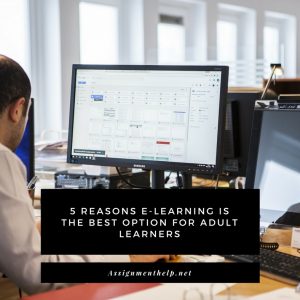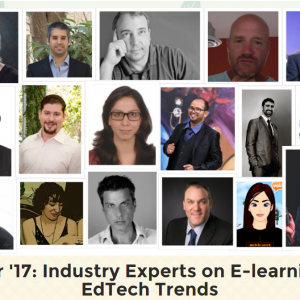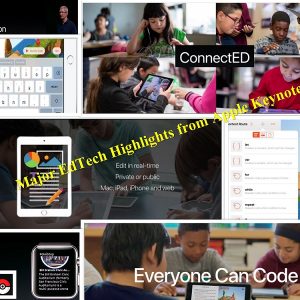The SAMR Model: Effective Technology Integration in Classrooms
Since the dawn of 21st century, the world has become more and more dependent on technology. Today, if you sit and take a look around, you will see yourself surrounded by all form of modern gadgets and previously unheard technologies. From your kitchen to your study table, from your very own cell phones to the appliances you generally use daily; technology has created a ubiquitous network around us. Technology has become important in every aspect of human life, from the time you wake up to the time you go to the bed. It makes work easy and fast, and in this fast running world who doesn’t want things to be done easy and efficiently.
The rise of technology in life has made it mandatory for institutions to make technology a part of the education process. Over the years, schools, colleges and classrooms have taken a number of steps to integrate technology in the pedagogy. . Sometimes it is a new online course and sometimes it is a new teaching approach to be soon introduced in classrooms.
“In education, technology can be a life-changer for kids. It can bring textbooks to life. It can connect students to their peers in other parts of the world. It can bridge the quality gaps.”- Queen Rania of Jordan
Technology has had a huge impact on this whole education system. It has improved the quality as well as the quantity of education. Keeping the present scenario in mind, both parents and teachers are in favor of schools to improve the technology they use in the classroom so that students get the knowledge and skills needed to compete in the real outside world. In the response to this need, schools have adopted a new pedagogical model– The SAMR Model
WHAT IS SAMR MODEL?
The digital revolution in education is full steam ahead, and this challenging process needs solutions on how technology will be used to change education. In 2006, Dr. Ruben Puentedura (P.hd), the President and Founder of Hippasus, a consulting firm based in Western Massachusetts, has come up with the perfect SAMR method to infuse technology into learning and teaching.
“There can be infinite uses of the computer and of new technology, but if teachers themselves are not able to bring it into the classroom and make it work, then it fails.”- Nancy Kassebaum
SAMR model prepares a framework that assists teachers to develop and inculcate digital learning experiences in the classrooms that promote the modern technology. This model enables teachers to not only infuse technology in teaching but also help them evaluate the technology used in the classroom. One thing you need to note here is that SAMR model is not just about simply using ‘technology for technology’s sake.’ It provides a technique for going through degrees of technology adoption to explore more meaningful uses of technology in teaching.
The model shows a sequence that teachers often follow as they progress through learning and teaching with technology. The first stage in this progress starts with the basic use of technology and as they move along the progression, technology becomes more important in the classroom. The Model basically transforms learning experience of students so that they get the higher level of achievement.
The SAMR model has classified the integration of technology in teaching and learning in four different levels. The higher the level of an assessment the greater the educational benefit.
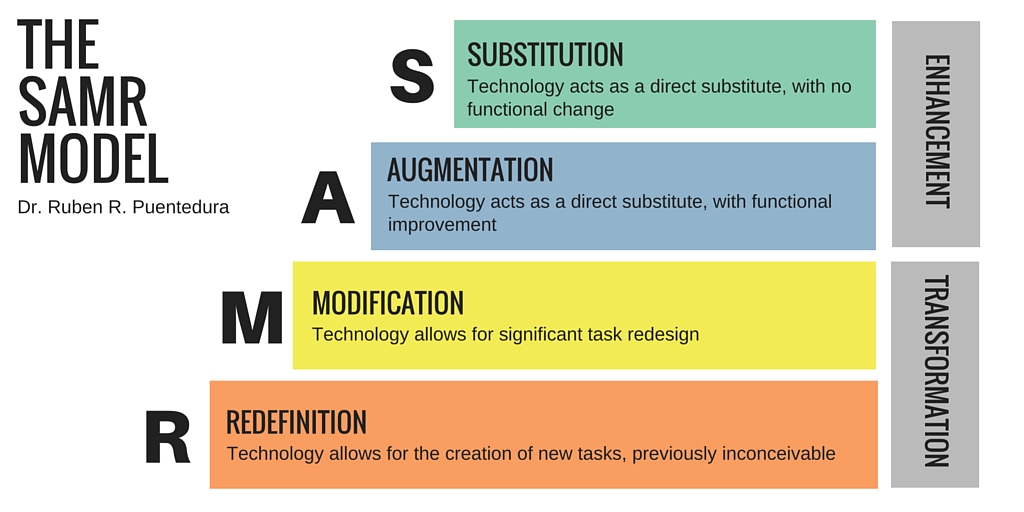
SUBSTITUTION
“Technology acts as a direct tool substitute, with no functional change”- Dr. Ruben Puentedura
Substitution is the ground level and it focuses on making life easier in the learning environment of a classroom. On this level, the integration of technology is very low. Technology is just used for things that cannot be executed without it. Students or teachers use new technology tools only to replace the old ones if required.
This phase is usually teacher centric in which the educator guides all the aspects of a lesson without the involvement of much technology.
Example: Suppose the original assignment was to ‘Read Romeo and Juliet play in traditional printed form.’ However, as a modern teacher, you decide to introduce SAMR model in the classroom to reduce the difficulty level for students. In the process, the first level for students will be to read Romeo and Juliet from an e-book or online.
AUGMENTATION
‘Technology acts as a direct tool substitute, with functional improvement”- Dr. Ruben Puentedura
Augmentation is just like substitution, but with few changes. Again on this stage, new technology is used in the classroom to substitute the old ones but with some functional benefits. The impacts of some functional changes make students more engaged in learning.
Students begin to take pleasure in learning because of the infusion of technology, which makes their learning easier and interesting. At this phase, the interaction from teacher centric level moves to teacher-student centric level, where teachers guide students on how to take advantage of very basic technological functions to work efficiently.
Example: We will here continue with the above-mentioned assignment. After reading Romeo and Juliet online; using different historical sites, study guides, online dictionaries, and going through more sites to supplement reading is Augmentation.
MODIFICATION
“Technology allows for significant task redesign”- Dr. Ruben Puentedura
This is the level where technology is used to actually transform the learning of students. The modification allows students to use technology effectively to redesign the new parts of the task rather than just doing the same task using different tools. This is the starting of using technology to accomplish common classroom task.
Students get familiar with the real outside world and the competition waiting beyond the school boundaries. This, in turn, boosts up their spirit and motivates them to achieve more.
Example: Students have completed their reading part. They have enhanced their knowledge about Romeo and Juliet with the help of technology. Now it is the time to transform their knowledge. The next task for students is to form a group of 4 to 5 people to research about a particular portion of the play.
To understand a portion of play better, they will use multimedia resources such as audio, text, video, hyperlinks, and images to jointly construct knowledge and enhance learning.
REDEFINITION
“Technology allows for the creation of new tasks, previously inconceivable”- Dr. Ruben Puentedura
Redefinition means that students use technology to create unnoticeably new tasks. Technology allows completion tasks that were previously beyond the level. At this phase classroom moves to student centered learning. Student starts to put up questions, raises queries and with the help of technology finds answers and solutions to their doubts.
Students become more of active learners rather being passive. They do not completely rely on teachers as a core knowledge disseminator. They become capable of unlocking the hidden treasure of knowledge unseen from other’s sight.
Example: After the whole research process, the next task of students is to create an animated video to answer the question, “What was the impact of the culture of the time having on the author’s writing?”
Students will use different online apps to fit images and words in a video. They will also record voice over, and create various artworks using a collaborative online whiteboard and put them in the video to make it more striking. They will then upload it to the YouTube and immediate start receiving feedbacks in the form of comments.
ARE YOU READY FOR TECH INTEGRATION?
“If you can do this lesson without technology that is great… but if you can do it better with technology, then go for it”
SAMR model is not a new approach; it is an effectual teaching process that will completely change your classroom environment. It is simple, easy to determine, and offers all teachers something to strive for. The SAMR model actually covers the entire spectrum of technology integration. To engage students in active learning teachers require an essential shift in the way they use technology to plan and execute subject material.
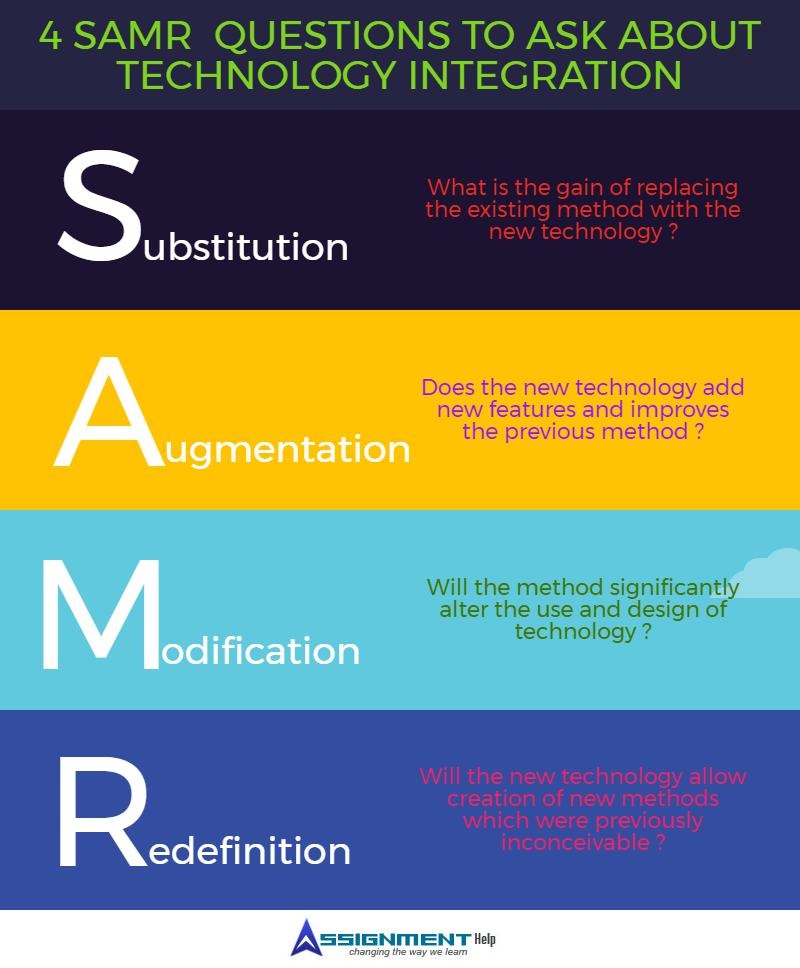
While introducing technology in your classroom, you should first answer following questions before and after using or suggesting any particular new technology to your students.
SUBSTITUTION
- What will be achieved by substituting the older technology with the new technology?
- Does this project really need the new technology?
AUGMENTATION
- Have an improvement is been added to the project process that could not be completed with the older technology at a fundamental level?
- How does this technology feature contribute to the instructional design?
MODIFICATION
- How is the original project being modified?
- Does this alteration primarily depend upon the new technology?
- How does this alteration contribute to instructional design?
REDEFINITION
- What is the new project?
- Will any segment of the original project be retained?
- How is the new project exclusively made possible by the new technology?
- How does it contribute to my instructional design?
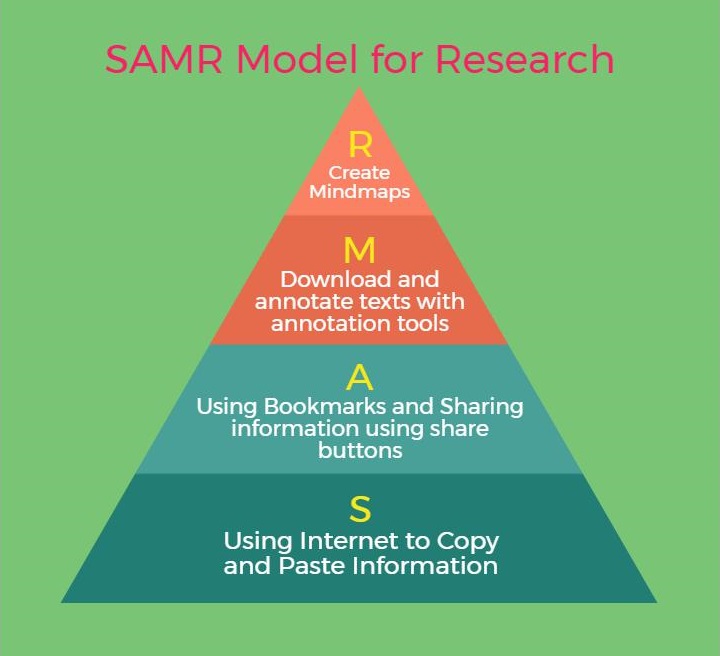
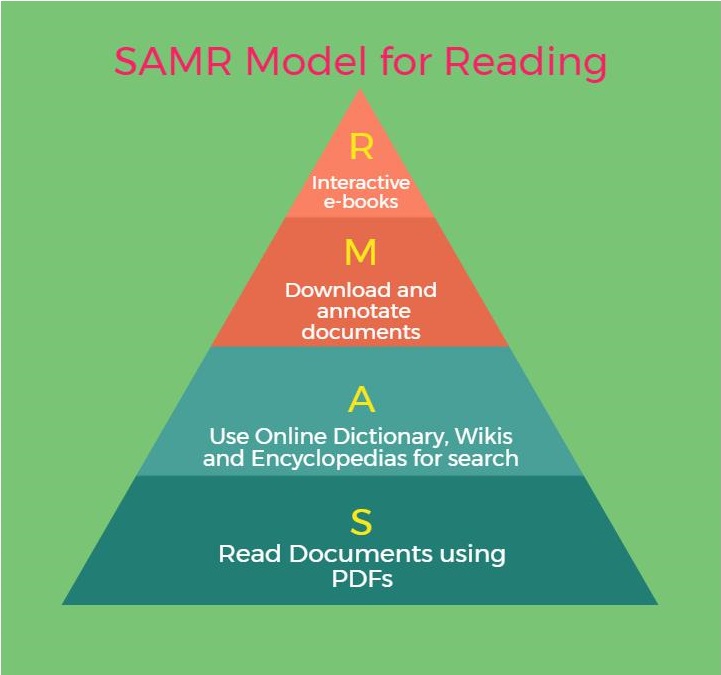
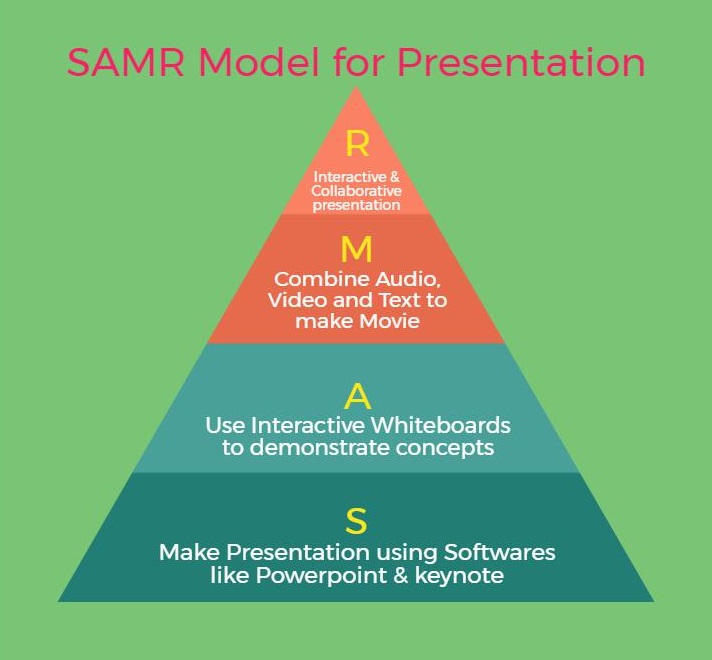
INTEGRATING EDTECH TOOLS: THE SAMR WAY
“The digital tools allow us to have control over what and how we can alter an image that was unimaginable in the era of analog photography.” – Pedro Meyer
The key to successful technology integration is the effective utilization of digital tools and you can choose an appropriate digital tool for the task only if you focus on specific requirements at each stage. It is important to note that neither the instructional design created by all the teachers nor all the digital tools are equal. To know which digital tool or app will be suitable for your task, you first clearly need to state your ambition of using it.
Here is a list of task when you can use digital tools instead of old technology
SUBSTITUTION
- To type report, essays, article or making presentation using Google docs
- To read online textbooks and respond to short-answer question using e-book reader
- To create self-grading text using Google forms
- To create basic assignments using Google forms
- To automate skills practice using resources like online dictionary or Daily Page
AUGMENTATION
- To streamline data collection using spreadsheets
- To access learning algorithms using app like Knowji
- To maintain digital portfolio of academic work
MODIFICATION
- To establish creativity using videos and images
- To make connections with people using social networking sites
- To create a dialogue with communities to find answers to your questions using Quora or Reddit
- To introduce multimedia in your digital portfolio using website like Crevao
- To socialize thinking using Google+ or Twitter
REDEFINITION
- To help students design their own learning path
- To connect students with experts using Skype or Hangouts
- To use Project based learning
Allan Carrington combined the bloom’s digital taxonomy wheel with SAMR model and created a Wheel of Padagogy. This wheel is the best reference for teachers who are unaware of edtech tools that are best suited for their pedagogical needs and classroom requirements. The wheel enlists all currently latest and useful apps that teachers are using in their classrooms and enlists their utility for bloom’s taxanomical objectives.
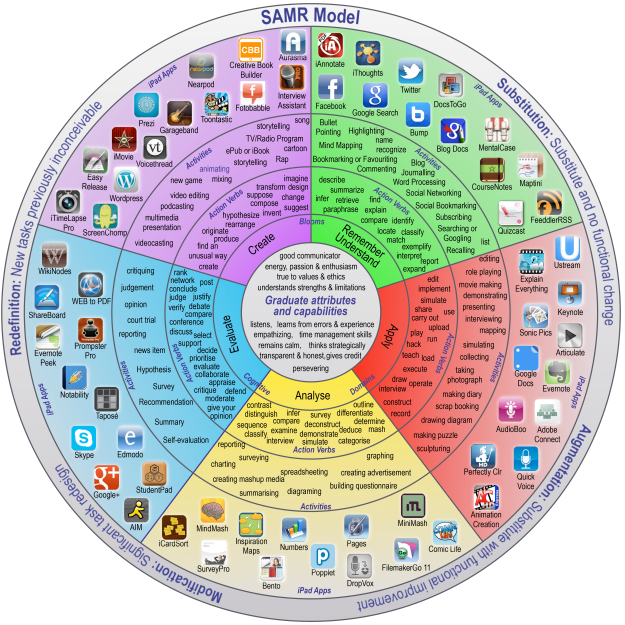
THINGS TO KEEP IN MIND
“SAMR is not just a guide to integrating technology, it is a guide to integrating ourselves into the digital age. It is a formula for change.” – @theedresearch
The SAMR model is mainly about providing a progression of knowledge through the use of technology. It is a tool for both evaluation and integration. There are few points for teachers to consider while introducing this model in your classroom.
- Never forget to ask the above mentioned question to yourself. It is very necessary to choose the right technology in the process of achieving fruitful results.
- The unification of technology in teaching is typically attained in specific levels. Jumping directly from the first stage to the last stage will not be helpful in achieving desired results. It will take small moves in design to successfully integrate technology to reach the next level.
- There is a direct relation between the level of unification activity and educational benefit. If you use technology in a meaningful manner to complete an assignment, then you will get higher educational benefits. The model moves in a systematic process from enhancement with Substitution and Augmentation to Transformation with Modification and Redefinition.
- If you want to achieve the desired results you need to select appropriate digital tools to accomplish the task. The successful unification of technology is achieved only through the effective use of digital tools.
FINAL THOUGHTS
The use of technology in education will change the learning experience of students, right? No, it is not a fundamental rule that only integrating new technology into planning will lead you to a better student learning outcomes. As we have said earlier in the substitution stage, don’t use technology just for the sake of using technology. If there are digital tools available in the market, don’t force yourself to incorporate them in your classrooms.
SAMR model doesn’t suggest that technology will make every lesson easier, it simply shows you a process to evaluate your use of technology to make better decisions about digital resources you are integrating into your classroom, which will support your instruction planning and ultimately, support your student’s learning.
If you place students at the center of the learning process, they can effectively create a powerful transformation in the traditional pattern of teaching. There is no doubt that technology can improve teaching and learning, but the fact is it is not a magic wand. You will not get favorable results simply by adding technology to a badly designed task. Technology will show its power only when it is in a great teacher’s hand.
Television didn’t transform education. Neither will be the internet. But it will be another tool for teachers to use in their effort to reach students in the classroom.”
